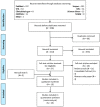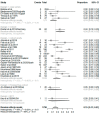Recurrence of Equinus Foot in Cerebral Palsy following Its Correction-A Meta-Analysis
- PMID: 35327713
- PMCID: PMC8947726
- DOI: 10.3390/children9030339
Recurrence of Equinus Foot in Cerebral Palsy following Its Correction-A Meta-Analysis
Abstract
Background: Recurrence in cerebral palsy (CP) patients who have undergone operative or non-operative correction varies greatly from one study to another. Therefore, we conducted this meta-analysis to determine the pooled rate of equinus recurrence following its correction either surgically or non-surgically. Methods: Nine electronic databases were searched from inception to 6 May 2021, and the search was updated on 13 August 2021. We included all studies that reported the recurrence rate of equinus following its correction among CP patients. The primary outcome was recurrence, where data were reported as a pooled event (PE) rate and its corresponding 95% confidence interval (CI). We used the Cochrane’s risk of bias (RoB-II) tool and ROBINS-I tool to assess the quality of included randomized and non-randomized trials, respectively. We conducted subgroup analyses to identify the sources of heterogeneity. Results: The overall rate of recurrence was 0.15 (95% CI: 0.05−0.18; I2 = 88%; p < 0.01). Subgroup analyses indicated that the laterality of CP, study design, and intervention type were significant contributors to heterogeneity. The recurrence rate of equinus differed among interventions; it was highest in the multilevel surgery group (PE = 0.27; 95% CI: 0.19−0.38) and lowest in the Ilizarov procedure group (PE = 0.10; 95% CI: 0.04−0.24). Twelve studies had a low risk of bias, eight had a moderate risk, and nine had a serious risk of bias. Conclusion: The recurrence of equinus following its correction, either surgically or non-surgically, in CP patients is notably high. However, due to the poor quality of available evidence, our findings should be interpreted with caution. Future studies are still warranted to determine the actual risk of equinus recurrence in CP.
Keywords: equinus; meta-analysis; recurrence; surgery.
Conflict of interest statement
The authors declare no conflict of interest.
Figures






Similar articles
-
Is the Prevalence of Equinus Foot in Cerebral Palsy Overestimated? Results from a Meta-Analysis of 4814 Feet.J Clin Med. 2021 Sep 13;10(18):4128. doi: 10.3390/jcm10184128. J Clin Med. 2021. PMID: 34575239 Free PMC article. Review.
-
Recurrence after surgery for equinus foot deformity in children with cerebral palsy: assessment of predisposing factors for recurrence in a long-term follow-up study.J Child Orthop. 2011 Aug;5(4):289-96. doi: 10.1007/s11832-011-0352-4. Epub 2011 Jun 24. J Child Orthop. 2011. PMID: 22852035 Free PMC article.
-
Surgical Management of Severe Equinus Deformity in Ambulatory Children With Cerebral Palsy.J Pediatr Orthop. 2023 Feb 1;43(2):91-98. doi: 10.1097/BPO.0000000000002310. Epub 2022 Nov 25. J Pediatr Orthop. 2023. PMID: 36607920
-
Recurrence of equinus foot deformity after tendo-achilles lengthening in patients with cerebral palsy.J Pediatr Orthop. 2015 Jun;35(4):419-25. doi: 10.1097/BPO.0000000000000278. J Pediatr Orthop. 2015. PMID: 25075893
-
Efficacy of conservative treatment for spastic cerebral palsy children with equinus gait: a systematic review and meta-analysis.J Orthop Surg Res. 2022 Sep 8;17(1):411. doi: 10.1186/s13018-022-03301-3. J Orthop Surg Res. 2022. PMID: 36076293 Free PMC article.
Cited by
-
Development of ankle and knee range of motion after isolated gastrocsoleus lengthening in children with cerebral palsy: a register-based longitudinal cohort study.Acta Orthop. 2025 Apr 17;96:331-338. doi: 10.2340/17453674.2025.43387. Acta Orthop. 2025. PMID: 40242883 Free PMC article.
-
Orthopedics and Trauma in Children: Key Problems and Future Insights.Children (Basel). 2023 Jan 6;10(1):119. doi: 10.3390/children10010119. Children (Basel). 2023. PMID: 36670669 Free PMC article.
References
-
- Lovell W.W., Winter R.B., Morrissy R.T., Weinstein S.L. Lovell and Winter’s Pediatric Orthopaedics. Lippincott Williams & Wilkins; Philadelphia, PA, USA: 2006.
-
- Rethlefsen S.A., Blumstein G., Kay R.M., Dorey F., Wren T.A. Prevalence of specific gait abnormalities in children with cerebral palsy revisited: Influence of age, prior surgery, and Gross Motor Function Classification System level. Dev. Med. Child Neurol. 2017;59:79–88. doi: 10.1111/dmcn.13205. - DOI - PubMed
Publication types
LinkOut - more resources
Full Text Sources
Miscellaneous

